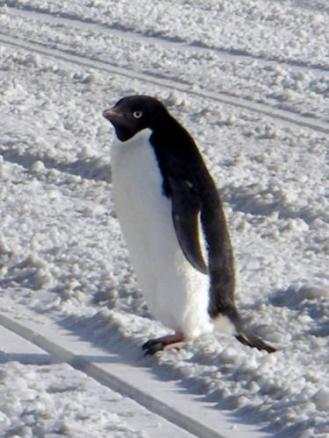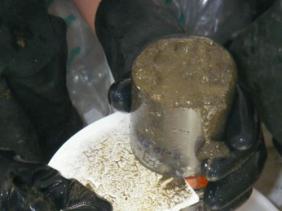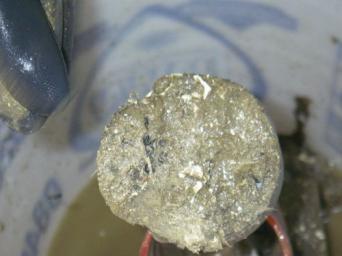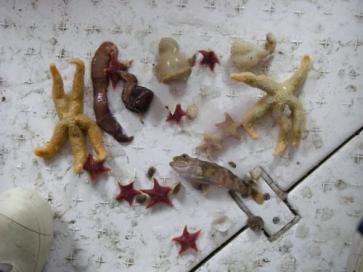Long Term Monitoring- the Why and What
November 28, 2007, Wednesday
McMurdo Station, Antarctica 9:45pm High: **+27F wind chill: +27F **Low: +10F wind chill -4F Winds: E 7-12 knts; Station Pressure: 28.910" Present Conditions: partly cloudy Sunset: February 20, 2008

Since Monday we have been at the dive hut watching the divers collect sediment cores and marine species from the three sample sites. These cores are then sectioned apart between what Terry can use and what Steve can use for their respective testing. I packaged up the marine creatures for Steve to puree into a liquid "chum" when he gets the shipment into his lab in April.
The three sites are called transects and they are located in Winter Quarters bay, by the outfall pipe and at Cape Armitage. A fourth control site will be included later this week because of the presence of a large concentration of sponge spicules, (exoskeletal parts of sponges made of silicon and calcium carbonate). Terry thinks that the concentration of the spicules is altering the microtoxicity readings in this area. To get an idea what the spicules look like, think of a furr ball that a cat would leave. I am wondering if there really aren't these huge and mysterious underwater cats that are producing these? That would have to be another study.
***Now for some background information about the area: ***
Winter Quarters Bay is a small cove of McMurdo Sound, Antarctica, located 2,200 miles due south of New Zealand at 77°50'S. Winter Quarter's bay is the portage area for McMurdo and the town is situated just above the bay. The ice breakers and supply ships will dock there in January when the sea ice breaks up. The harbor is the southern-most port in the Southern Ocean. The bay is approximately 250m wide and long, with a maximum depth of 33m. The name Winters Quarters Bay refers to Robert Falcon Scott's National Antarctic Discovery Expedition (1901-04) which wintered at the site for two seasons.
Operations at McMurdo Station, since1955, have led to severely polluted waters at Winter Quarters Bay. Until 1981, trash, waste and unusable equipment were dumped into the bay. This included heavy equipment, chemical drums, fuel tanks, shipping containers and an airplane. Longtime seasonal workers report watching heavy equipment placed out on the ice for the purpose of sinking when the ice broke apart.
In addition, sediments in the bay are contaminated with PCBs, metals, and hydrocarbon fuels. A January 2005 edition of the Antarctic Sun, a U.S. National Science Foundation publication, noted that a former landfill located on a hill above the bay is considered to have been a primary source of the fuel and PCB contaminants. PCBs, now banned in the United States, were used in electrical and heating systems. A 1990 study found that PCBs in the water were also produced by marine shop wastes and ships pumping their bilges while docked.
Under the Antarctic Treaty, the United States and the National Science Foundation are obligated to maintain and support the longterm environmental impact of the station. "The environmental protocol extends and improves the Antarctic treaty effectiveness in ensuring the protection of the Antarctic Environment."
The goals of the monitoring program at McMurdo Station are:
- Establish the "footprint" of the station and determine whether it is increasing or decreasing in size over time and in response to management decisions. 2. Establish whether known areas of "heavy" impact are stable and contained by efforts to date to remediate the sites. 3. Document the impact or effect of specific activities. 4. Finally, provide an overall assessment of the condition of the system
This long term monitoring program is carried out in the terrestrial and the marine environment measuring a selection of indicators of potential environmental contamination.
***Back to the sampling: *** At each site there are three sets of samples collected, 7 cores in shallow, medium and deep waters each.
Transect 1 was in the center of the back portion of Winter Quarter's Bay, just off of the ice pier. Transect 2, the outfall pipe, is a pipe that runs out from the water treatment plant into the bay. The water treatment plant processes up to 70,000 gallons of waste water each day. Solid waste is eventually compacted, de-hydrated and packed into about 70 one ton boxes that are shipped back to the US on the supply ship that returns in March. For more pictures and information about the water treatment facility, please see Mindy Bell's coverage of it in her PolarTREC journal entry. The outfall pipe delivers clean salt water back into the bay through the pipe that runs just off shore into the bay.

*Transect 3 *is at Cape Armitage. This is the control site on the south side of McMurdo.

A fourth transect is going to be sampled on the north side of McMurdo, hopefully out of the spicule area for sponges. This will be just on the other side of Hut point. Hut point is the location of Scott's Discovery hut, constructed in 1904.
In addition, to core samples marine samples are also collected

Marine Sample from Cape Armitage, Transect 3
The core samples are tested for trace metals, microtoxicity, macrofauna and grain size. The marine samples are tested for PCB's, PAH (polynucleated hydrocarbons), total organic and inorganic carbons.
***Be sure to look at the photo gallery at the many many more pictures of this area!! ***
Have A Great Day on Planet Earth!
cheers,
Ann


Comments